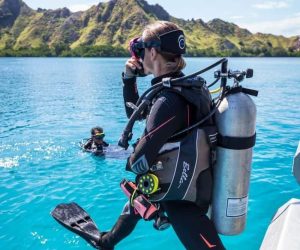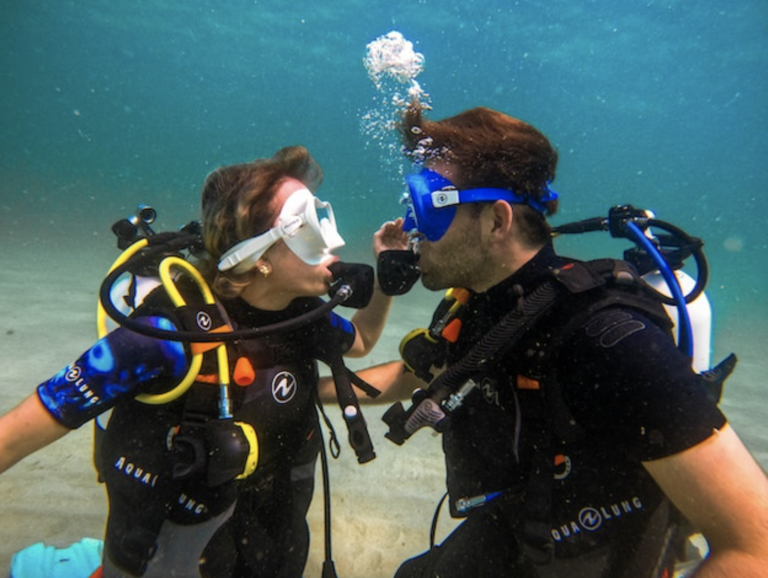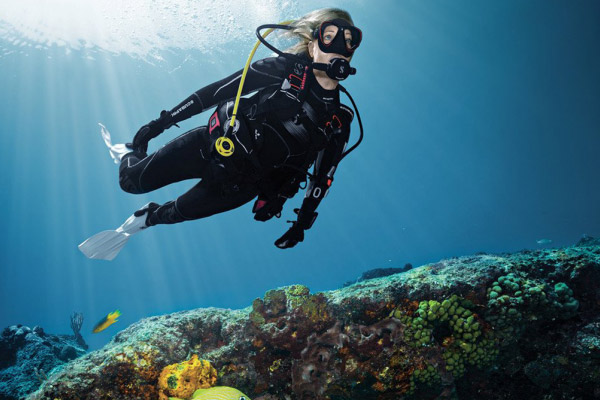There is no doubt that diving is a practice that fascinates people from all over the world, after all, the underwater world is extensive, rich, complex and deserves to be explored. This content will teach you in detail everything you need to know to scuba dive.
However, this is a topic that raises many doubts and curiosities that need to be properly clarified.
Bearing this in mind, this content was prepared with the purpose of serving as a true guide on diving so that beginners become familiar with the topic.
Through didactic and informative language, the main points on the subject will be addressed throughout this article, so that you can have a complete overview of diving.
So get ready to dive headfirst into a completely fascinating and enchanting world!
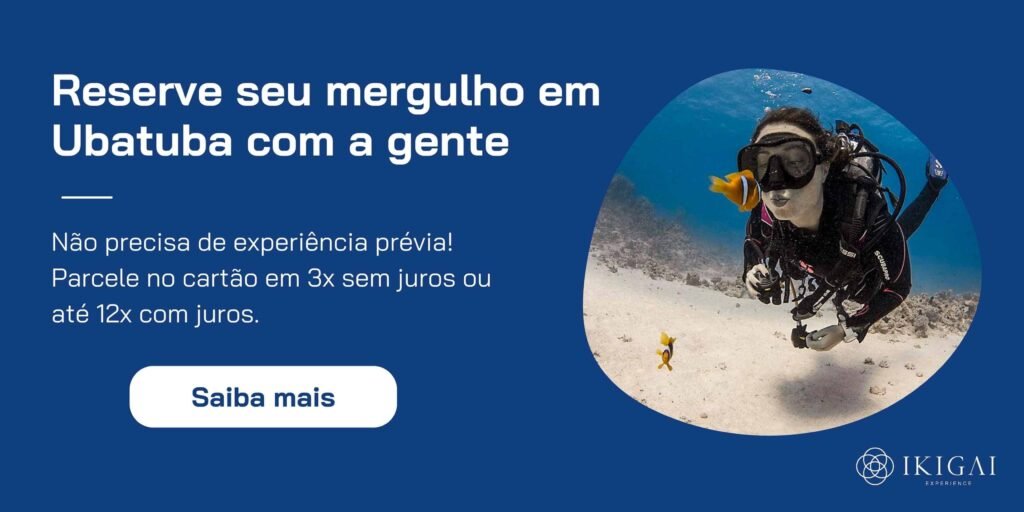
Contents
What is diving?
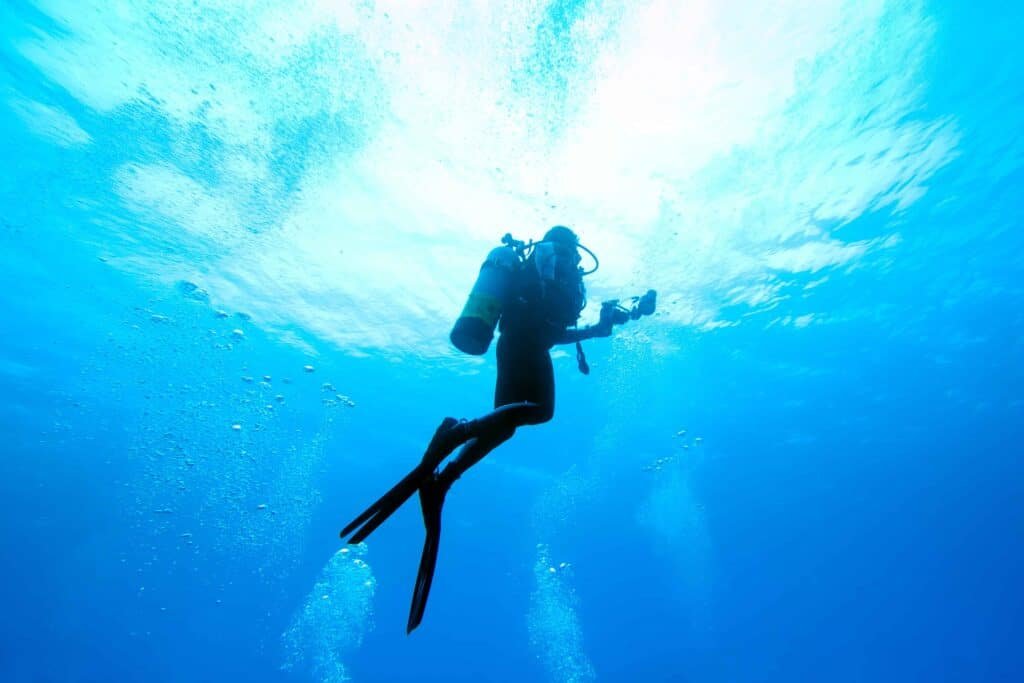
Diving is considered as an activity practiced on the seabed and that can be performed in two ways: dependent and independent.
Dependent diving, also called scuba diving, is performed with the aid of a cylinder.
Independent diving is the one practiced only with breath control.
This content will focus on the first form of diving, the dependent.
A brief history of diving
Diving has its origin linked to the constant need of the human being to expand the limits of knowledge.
The beginning of diving as practice professional happened more than 4,000 years ago.
At first, efforts were limited to shallower waters, where divers collected various materials of great commercial importance, such as pearls, food, corals and sponges.
Over the years, the need to make the diver remain submerged in the water for longer has increased.
In this scenario, pieces of hollow reeds were used in the first attempts to connect the diver to the surface.
In this way, the user was able to stay submerged for longer.
These techniques ended up being more used in military operations, which allowed a discreet approach to enemy bases.
Augustus Siebe was the first to develop the functional diving suit, designing a seal between the suit and the helmet that allowed the diver, under the helmet, to exhale air without water entering.

Back in 1943, during World War II, Jacques-Yves Cousteau was the first to dive off the Provençal coast to a depth of up to 20 meters with the help of equipment he designed, the aqualung.
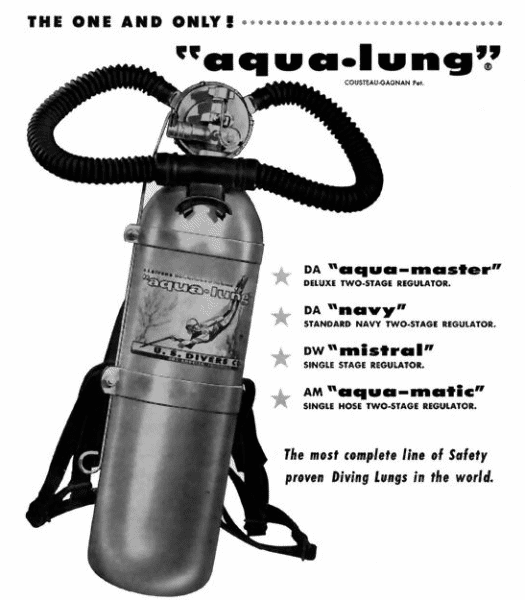
This device was a true water lung, paving the way for modern and new diving equipment.
Types of Diving
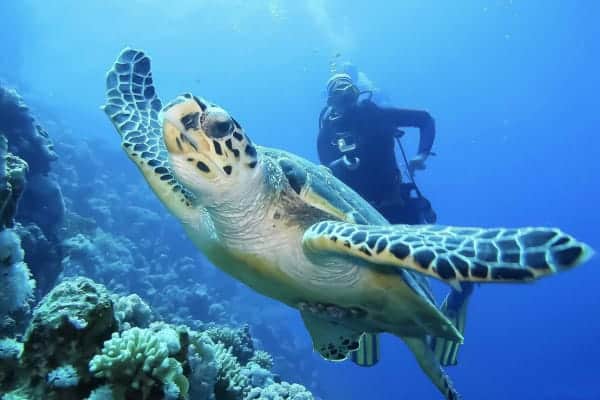
Now it's time to address the main types of diving that exist in the world, so that you can understand the extent of this exciting activity.
1. Freediving
In freediving, the diver practices the sport without the use of any underwater breathing apparatus.
This modality requires good physical preparation, as well as lung capacity and emotional control.
The practice usually occurs in shallow waters.
Freediving includes modalities that may or may not be competitive, such as:
- Contemplative diving: is the one practiced only by divers who wish to contemplate the aquatic environment;
- Immersion book: this modality is aimed at those who like adventures. In this case, the diver uses a cable to emerge as much as possible and, shortly after, return to the surface;
- No limits: no limits is a modality aimed at those who enjoy diving in the depths. The return to the surface is carried out with the help of an inflatable vest, balloon or other mechanical means that make the ascent faster.
1.1 Snorkeling
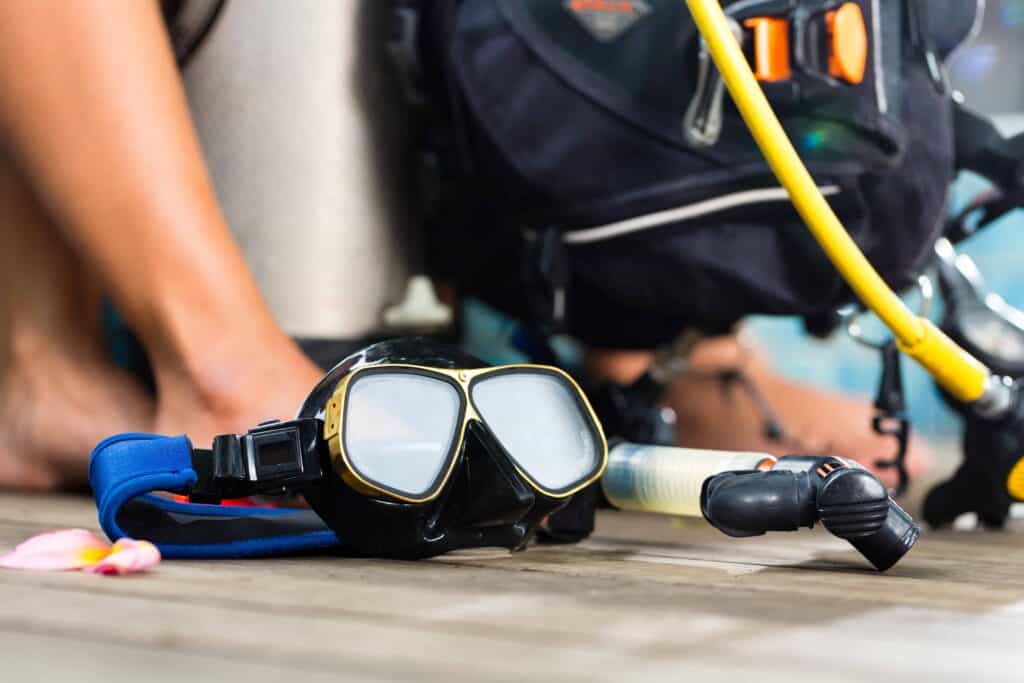
Snorkeling is the easiest way for a diver to have his first contact with the aquatic environment.
This type of diving can be practiced by basically anyone.
It is enough for the practitioner to wear a mask, a pair of fins and a snorkel.
The snorkel is nothing more than the tube used for breathing while the diver remains underwater.
The most recommended environments for the practice of this type of diving are the seas, rivers and natural pools.
1.2 Apnea diving
In apnea diving, unlike what happens with the autonomous diver, the diver relies only on the air in the lungs.
This type of diving is practiced every time someone swims and holds their breath underwater, for example.
In fact, apnea diving is a freediving modality, which has already been mentioned above.

2. Scuba diving
Scuba diving, in turn, is one in which the diver uses his own device to practice this activity.
The device is called Self Contained Underwater Breathing Apparatus (SCUBA), which provides 100% of autonomy so that the diver can breathe in the aquatic environment through the air cylinder.
Thus, he will be able to perform the submersion for a much longer period.
Therefore, this type of diving is recommended for those who want to explore the depths of the sea and its wonders.
2.1 Baptism diving
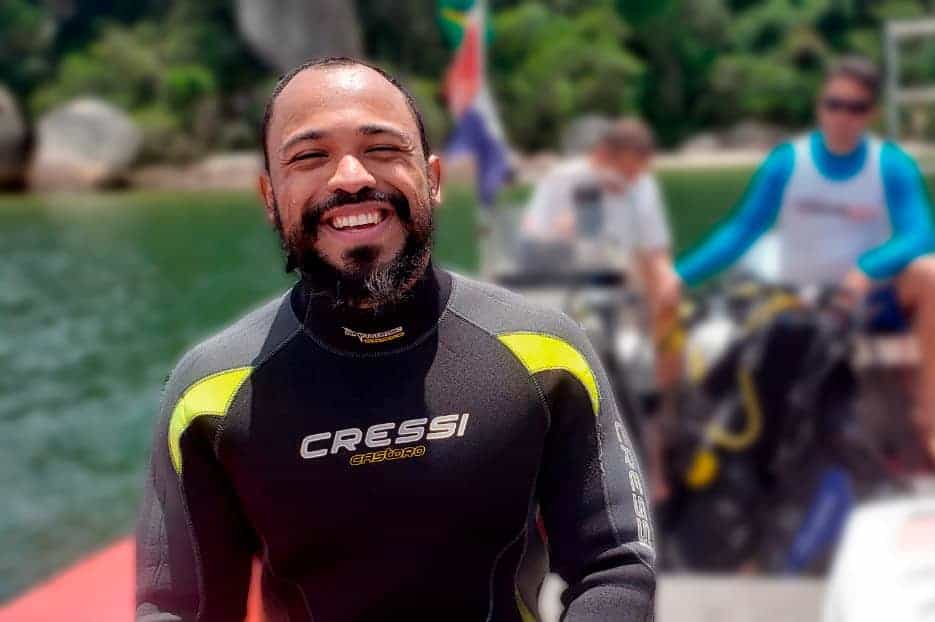
Those who have the desire to dive, however, have no experience, can explore the seabed through baptism diving.
This practice is intended for people who have never taken a diving course. In this dive, it is possible to discover the entire underwater universe without any prerequisites, not even knowing how to swim. You will be able to see marine life, such as species of fish, corals, turtles and schools of fish passing by.
Because of this, the activity is usually practiced in suitable places for beginners and, of course, with the accompaniment of a trained and specialized professional.
Do you need to know how to swim to dive?
This is a very common question among people who want to practice scuba diving.
And the good news is that you don't need to know how to swim or have experience to dive.
Before the practice is effectively started, the practitioner undergoes a brief introductory class in a swimming pool.
At that moment, the instructor will transmit the main information about the movements and other actions that the practitioner must perform underwater.
Diving is a very democratic activity, being accessible even for children.
Of course, precautions must be taken, however, it is not necessary that the person has mastery of swimming.
2.2 Diving for Accredited
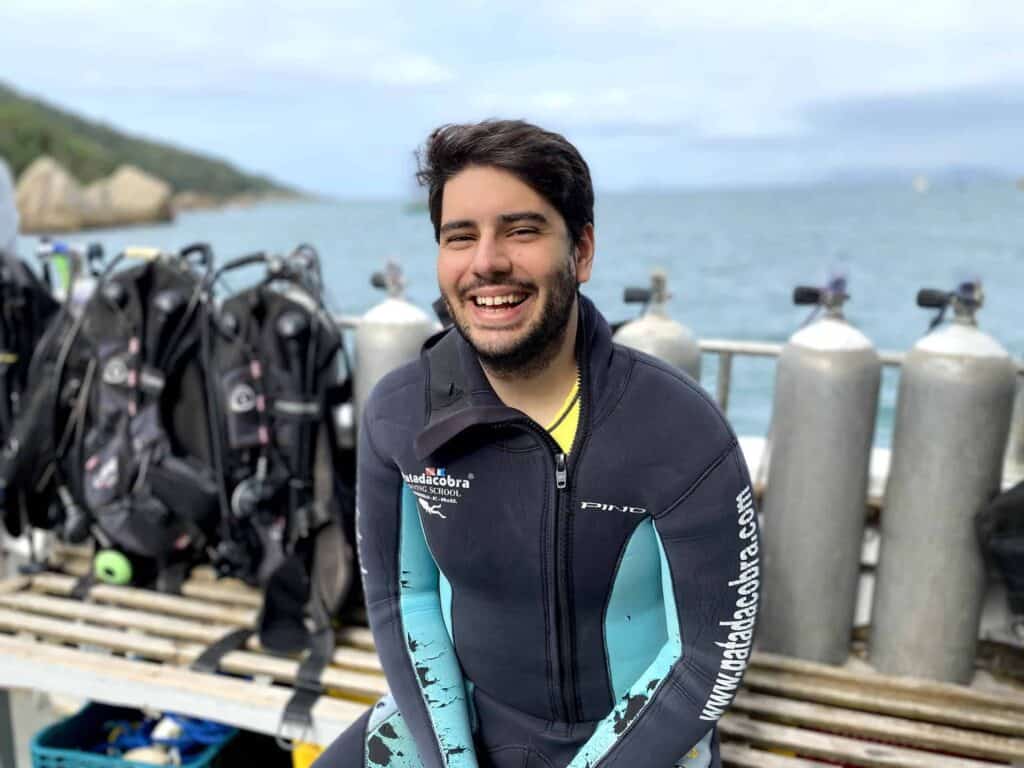
Accredited diving is intended for divers who already have completed the course with the basic diving certification.
To carry out a dive, it is important to have a buddy to accompany you, diving alone is not allowed.
As they already have certifications, there is greater freedom to explore different points, normally not accessible for baptism dives, such as shipwrecks.
Such dives can range in depth from 6 to 18 meters for divers with basic certifications.
For those with advanced certifications up to 32 meters or even deeper dives for more experienced technical divers.
2.3 Technical diving
Technical diving, as its name suggests, involves techniques that go far beyond simply recreational diving.
Among the characteristics of this type of diving, the following stand out:
- Depth above 40 meters;
- Stage decompression required;
- Accelerated decompression and/or use of a variable gas mixture while the dive is being performed;
- Use of comprehensive technologies and devices;
In technical diving, the surface is often inaccessible in the event of an emergency, so divers use equipment and procedures to properly manage risks and potential hazards.
In addition, they have an extensive training program.training, so that they become qualified to practice such activity.
2.4. scientific diving
Finally, there is scientific diving, a very important type of diving for the science area, covering biologists, archaeologists, oceanographers, ecologists, as well as other scientists.
Thus, it is a fundamental tool for applied sciences to issues involving fisheries, environmental damage, energy resources, among others.
Scientific diving aims to collect scientific data so that it can support important research.
In addition, it provides a great content of knowledge for the sciences related to the underwater world.
3. Saturation Dive
Saturation diving is that practiced at depths that exceed 50 meters.
The name is justified by the fact that, at depths of this level, the diver reaches the maximum limit of absorption of gases that are present in the respiratory mixture, so that it becomes saturated.
Saturated diving is based on the premise that the pressure of the gas that is present in the lungs is the same as that of the gases that are dissolved in tissue and blood.
This means that the diver will descend to a great depth and remain there until the moment when there is no more gas to dissolve with the gases that will be saturated with nitrogen.
diving certifiers

Now that you are more familiar with the world of diving and one step away from starting to practice this interesting activity, it's time to know what diving certifiers are, the main certifications and other important points on the subject.
1. What are diving certifiers
Diving certifiers are nothing more than institutions that are responsible for regulating the practice of diving.
They recognize and guarantee the validity of all courses that are offered for that purpose.
Through them, quality is certified at all times, whether before, during or even after training.
The certifiers are practically new in Brazil, however, they have already achieved a notable highlight in the diving segment.
It is true to say that all the international recognition and experience they have managed to radically transform the Brazilian diving market.
It is up to the associations the role of making the learning methods available, whether practical or theoretical, to the schools that are affiliated with them.
It is also worth noting that the teaching methods offered by the certifiers are all standardized.
This means that the diving certificate goes far beyond just a bureaucratic authorization, being considered a true recognition, confirmed that the student has, in fact, mastered internationally recognized diving techniques.
After completing the diving course, it is through the certifiers that the student is able to acquire the dreamed and deserved diver certificate.
Today, there are several certifiers operating in the market, such as PADI, NAUI, PDIC, SSI, CMAS, ADS, among others.
Next, we will cover the main ones, so that you can get to know their working dynamics in more detail. Check out!
2. Main diving certifiers

2.1 PADI (Professional Association of Diving Instructors)
The first certification that we will address is PADI, which in free translation means Professional Association of Diving Instructors.
Considered a leader in the diving market, its seal is accepted and recognized in more than 180 countries, making it the most chosen by beginners.
PADI was founded in 1966 in the USA by instructors who belonged to NAUI, another certification body.
Since then, she has been responsible for training more than 20 million divers from all over the world.
The teaching material offered by her has already been made available and translated into 26 languages.
According to estimates, for every 100 recreational divers in the world, 7 are certified by PADI.
PADI was developed with the aim of making divers training more didactic. For this, the course was divided into modules, facilitating learning.
Finally, it is worth mentioning that the certifier offers an extensive catalog of specialization, certification and professionalization courses.
2.2 NAUI (National Association of Underwater Instructors)
NAUI is another top dive certification body, being the largest scuba training NGO on the planet.
It was created in California, in 1960, with the purpose of teaching, to the members of the association, the main techniques applied in diving.
NAUI has the following motto “diving safety through education”, being the first association to offer diving education in the USA. It currently operates in more than 90 countries.
Regarding its catalog of courses, it is considered to be leaner when compared to the PADI one. This is because its main focus is academic and technical activities.
Because of its credibility and history, NAUI is the organization that acts most prominently in the military and scientific fields.
2.3 SSI (Scuba Schools International)
Also one of the most respected and well-known certifiers, SSI has been in business for over 45 years, providing resources for training divers around the world.
Currently present in more than 110 countries, it has its teaching materials in more than 25 languages.
In recent years, it has stood out for its modernization and ease of training new divers, with its robust e-learning systems.
Since 2010 SSI has become one of the few agencies with international recognition.

3. Benefits provided by the diving certificate
First, the certificate is recognized all over the world, so that the diver can practice this activity anywhere, in a regularized and safe way.
In addition, certification provides more autonomy for the diver, as he will be able to perform the practice without the help of an instructor.
In this way, it is possible to have more freedom in movement, exploration of the site and decision-making during the dive.
Finally, the certificate is a basic requirement for you to do various specializations offered by the activity.
After the basic diving course certificate is acquired, you can take the next step, that is, put into practice all the learning acquired in the course.
Afterwards, the diver can, if desired, learn new skills through the advanced diving course.
In this case, it is possible to develop new activities underwater, such as exploring caves and shipwrecks, underwater photography, etc.
Below are some levels and specializations of existing certifications, we remind you that these are just some of them, which also vary greatly from certifier to certifier, both in name and in competences:
- Open Water Diver
- Advanced Open Water Diver
- Rescue Diver
- divemaster
- Master Scuba Diver
- Night Diver
- Enriched Air Diver
- Underwater Photographer
- Underwater Videographer
Is diving a dangerous practice?
Many people wonder if diving is a dangerous activity, after all, the circumstances in which it is performed end up causing a certain fear for beginners.
In this topic we are going to talk about the risks that the practice of diving offers, the precautions that must be taken and the people with clinical conditions who should avoid such activity.
This is because diving is a practice that involves some points of attention, so that it is carried out in a safe and peaceful way. Therefore, it is essential to know them in detail.
1. Diving hazards
Diving, whatever the type or frequency with which it is practiced, is a very safe and peaceful activity, however, certain precautions need to be taken, as in any other extreme sport.
If you have any health complications, it is recommended that when diving, you contact your doctor in advance regarding the experience.
2. Precautions that must be taken when diving
If you want to dive in a calm and safe way, know that you need to be surrounded by some precautions that will considerably minimize all the risks mentioned in the previous topic,
Thus, to practice diving, the diver must:
- Balance the pressure in the various air spaces, which includes the face mask and middle ear;
- Avoid holding your breath, choosing to breathe naturally when ascending. It is worth noting that the ascent must occur at a speed that allows the diver to expel the nitrogen little by little and empty the spaces filled with air, such as the sinuses and lungs, for example;
- Try to make the recommended stops according to the dive time and depth;
- Do not fly within 15 hours of the dive;
In order for other risks to be minimized with the practice of diving, it is essential that the diver is aware of and avoids certain circumstances, such as:
- Compromised visibility;
- Currents that demand an excessive effort;
- Low temperatures;
- Diving without the accompaniment of other people;
- Ingestion of alcohol, sedatives and drugs;
It is worth mentioning that the low temperature represents an additional danger, since it offers the risk of rapid development of hypothermia, which compromises the diver's dexterity and judgment.
In addition, hypothermia causes an abnormality of the heartbeat, which becomes a symptom of potential fatality in more susceptible people.
Finally, it is important to remember that the ingestion of sedatives, alcohol and other drugs, regardless of the amount, can cause some unpredictable effects, so they must be completely avoided by the practitioner before the activity.
3. Clinical conditions incompatible with the practice of diving
As is well known, diving is a practice that involves greater effort, thus requiring a great lung and aerobic capacity from the diver.
Thus, the person cannot present limitations in this sense, such as lung and heart diseases.
Most of the time, people who have disorders capable of affecting the state of consciousness, judgment or alertness, such as diabetes and seizures, are unable to practice diving.
In relation to diabetes, it should be noted that specific programs were created aimed at divers affected by this disease, which means a great advance for this branch of activity.
In any case, it is essential that the doctor is consulted in case of doubts, in order to make sure that the person is fully fit to practice diving safely.
Regarding children under the age of 10, the guidelines are that the practice is not recommended, although there are successful programs that promote diving education for this age group.
For those who are professional divers, it is important that medical examinations are carried out with a certain frequency, in order to always certify the health of the lungs, heart, vision, hearing, in addition to checking that the physical capacity is intact.
Top diving spots in Brazil

Okay, now you can consider yourself familiar with the world of diving. However, one last fundamental point is missing: knowing which are the main diving spots that exist in Brazil.
After all, there's no point in mastering theory if you don't know the main places to put everything into practice. And we know that the places to visit in Brazil are varied, but in almost all of them there are good options for diving.
Therefore, check below the most favorable places to practice this activity, so that you can choose the one that best suits your profile.
And from now on, it is important that you know that diving does not necessarily have to be practiced in beach.
Many of the destinations that are very popular for the practice of this activity end up being caves, rivers and lakes.
In addition, anyone who thinks they need to go very far to dive is wrong. Below you will see that many places are closer than you think. Check out!
1. Ilhabela, São Paulo
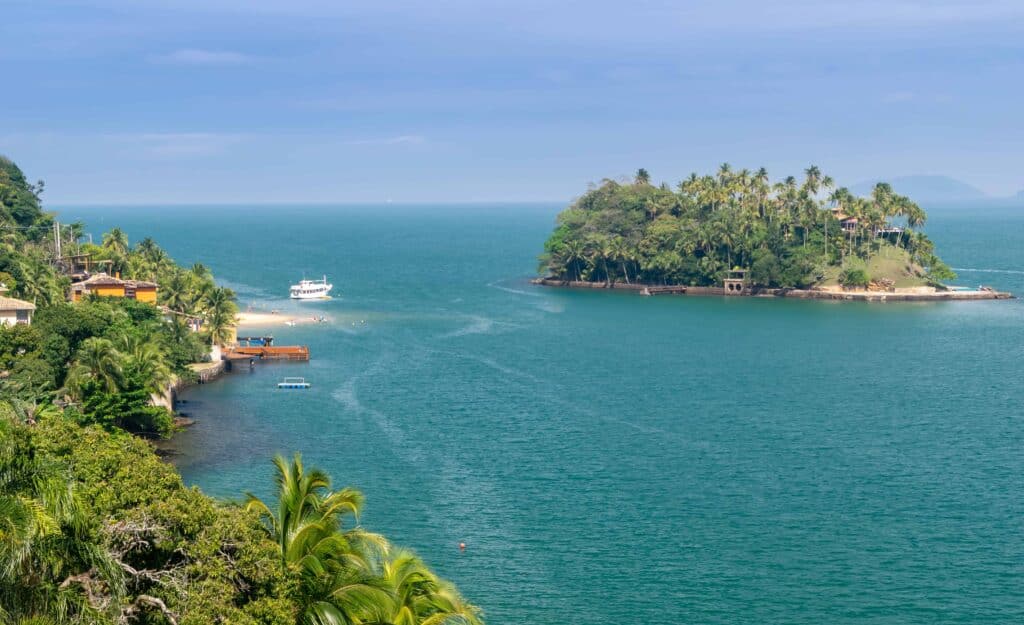
Another destination that stands out for the large number of shipwrecks is Ilhabela, a place that attracts divers from local divers.
In the preserved regions, visitors are faced with a great wealth of fauna and flora.
With the practice of diving in place, it is possible to see bass, butterfly fish and other fantastic species.
The depths of Ilhabela's sea also have large rocks formed by starfish, corals, colorful fish and sea squirts.
In short, everything converges to an incredible and unforgettable experience. It's definitely worth it! See more at dip in Ilhabela.
2. Arraial do Cabo, Rio de Janeiro
Arraial do Cabo is located in the coastal region of the state of Rio de Janeiro, popularly known as the Caribbean of Brazil.
The water with shades of blue, the white sand and the excellent visibility are qualities that attract divers from the most varied places.
Even if the water temperature reaches 15º C, diving can be done with ease, as long as the practitioner wears suitable clothing for these environments.
This scenario provides an abundant marine life, in addition to being atypical when compared to other dive sites.
During the activity, the diver often comes across turtles, seahorses, whales, rays and dolphins.
Even orcas and penguins have the habit of visiting the place, making the experience even more incredible and remarkable.
It is also worth noting that Arraial do Cabo is considered one of the best diving spots for beginners. Find out more about the experience at diving in Arraial do Cabo.
3. Buzios, Rio de Janeiro
Like Arraial do Cabo, Buzios is located in the Lagos Region, in the state of Rio de Janeiro.
The peninsula is 8 kilometers long and receives sea currents from the South Pole and the Equator, so the beaches alternate between cold and warm waters.
The place is inhabited by a very diverse and rich marine life due to upwelling, a phenomenon characterized by the presence of icy ocean currents that come from the south, responsible for transporting various nutrients.
This condition ends up attracting turtles, schools of fish and stingrays, species present in large numbers and seen frequently.
All this makes the diving practiced in Búzios be a unique and incredible experience, both for beginners and for more experienced divers.
4. Cabo Frio, Rio de Janeiro
Like Buzios and Arraial do Cabo, this diving spot is also located in the Lagos Region, in Rio de Janeiro.
The place is known for the great variety of fauna and flora and for the very clear waters, guaranteeing excellent visibility under the water.
See the full experience Diving in Cabo Frio.
5. Ilha Grande, Rio de Janeiro
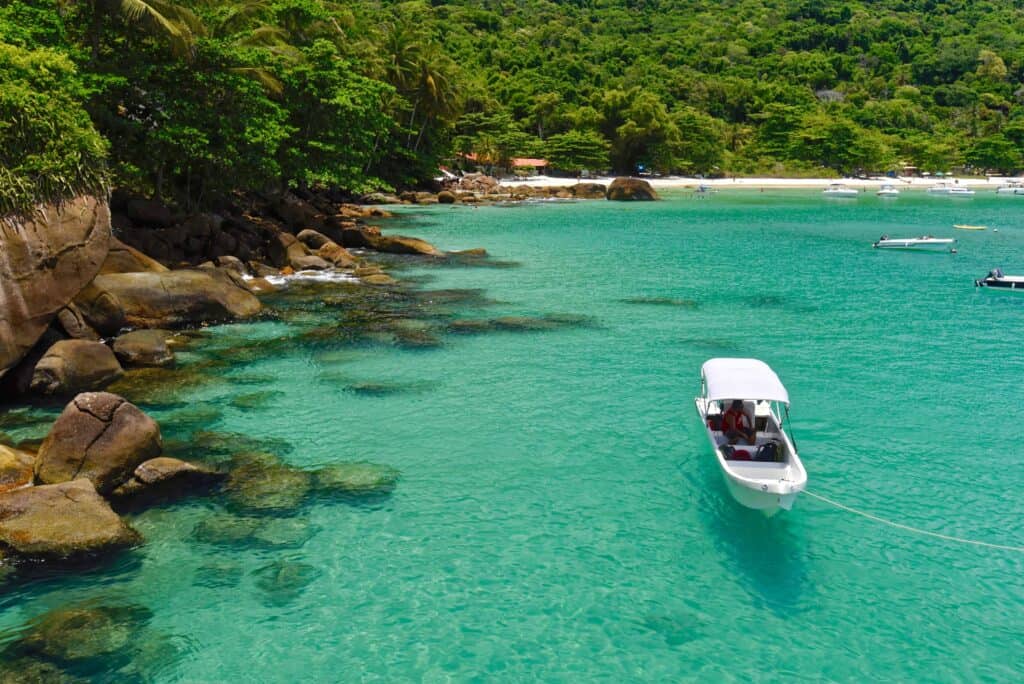
Another popular spot for divers is Ilha Grande, known for its clear waters and emerald green tones.
Whatever region of the island the visitor is in, it is possible to swim in the midst of the colorful fish.
A trademark of this destination is, without a doubt, the starfish, which are found in abundance, forming a kind of maritime constellation.
Furthermore, Ilha Grande offers an extensive variety of flora and fauna species, identified in the deepest waters of Ilha Grande Bay.
If you want to be surprised by the diversity, Laje Alagada is the right place, where the cracks opened in the giant rock formations flow into halls with white sand filled with starfish.
Laje Branca, in turn, is another place much visited by divers, as it has a large number of species and rock formations.
If you want to practice diving in submerged vessels, you should visit the Shipwreck of the Pinguino Ship, one of the most popular spots on the island.
There, you can find rays, seahorses and whiting swimming around the structure. Learn more about the Diving in Ilha Grande.
6. Fernando de Noronha, Pernambuco
Another destination considered by experts as one of the best places to dive is Fernando de Noronha.
The archipelago located in the state of Pernambuco offers warm waters and excellent horizontal visibility, reaching 50 meters, making it easier for visitors to observe marine life.
Not to mention the wide variety of places to dive, after all, the destination offers more than 30 diving options, each with a different depth, which ends up satisfying all divers profiles, from beginners to professionals.
Among the most sought after spots by visitors, Pedra da Sapata, Cabeça das Cordas and Laje Dois Irmãos stand out.
If you are looking for great adventures, you will certainly be surprised by the species of marine animals that inhabit the waters of Fernando de Noronha.
After all, the archipelago is located in the middle of the ocean, unlike the coastal beaches, so it receives a wide variety of migratory animals such as whales, sharks and dolphins.
Not to mention the ease with which divers come across shoals, octopus, moray eels, rays, sea turtles, etc.

7. Florianópolis, Santa Catarina

When talking about the main diving spots in Brazil. floripa cannot be left out, being the place that will close this topic with a flourish.
The place is known for its great natural beauty, which includes beautiful beaches, lagoons, rainforest and, of course, excellent diving spots.
Among the options, the Diving in Xavier Island, where the waters have a depth that can reach 18 meters, being an excellent option for those who want to know marine life in more detail.
Another diving point in Floripa is Ilha do Arvoredo, which is part of the Arvoredo Marine Biological Reserve, along with the islands of Deserta, Calhau de São Pedro and Galés.
Diving at Ilha do Arvoredo provides, on average, 10 meters of visibility during practice, eventually reaching 18 meters.
The experience is unforgettable, as the diver has the chance to observe many marine animals, plants and fish.
Among the fish that are most often seen, the marimbau stand out, with a length of approximately 2 palms, the sergeant, known for its dark stripes, the damsel of rocas, with yellowish tones, among others.
There are also small corals, which, when touched, close up.
Turtles and octopuses are also very common animals to be seen.
Another option for diving in Florianópolis is Ilha do Mata Fome, which faces Praia dos Ingleses and is located in the northern region of Florianópolis.
Arrival on the island takes approximately 10 minutes when you depart by boat from Praia dos Ingleses, on its right corner.
In the region close to the island, the bottom is very rocky, however, it becomes sandy as you move away from it.
The water depth can vary from 4 to 12 meters.
Among the species that are most often found during diving, there are turtles, salemas, monks, groupers, cheetah rays, damsels, trobeta fish, maria da burro, corals and dog's eye.
8. Maragogi, Alagoas
Maragogi is known for its beautiful natural pools, attracting thousands of divers.
The municipality also houses the APA (Costa dos Corais Environmental Protection Area), protecting one of the richest ecosystems in Brazil.
The warm and clear waters and the coral bank attract hundreds of tourists who prefer more tranquility when diving.
In the warm waters of Maragogi it is possible to find corals, fish and crustaceans of the most varied species.
There are also the two shipwrecks located on the coast of the city, being a great destination for more experienced divers.
It is certainly a destination that will offer more radical experiences in the depths of the waters. Discover more about the experience of Diving in Maragogi.
9. Guarapari, Espírito Santo
Guarapari is located a few kilometers from Vitória, capital of Espirito Santo, being a place that houses a rich and extensive diversity of fish.
According to the data, 220 species were identified in the region, which can be observed during scuba diving or snorkelling.
There are also several options for diving, such as reefs, shipwrecks and islands.
The region's waters are practically clean, providing excellent visibility, which guarantees a fantastic experience through the observation of rays, fish and turtles.
In Ilhas Rasas, tourists can, for example, photograph and film moray eels, parus and peroas, in addition to the exotic batfish. See more about Diving in Guarapari.
10. Ubatuba
Ubatuba is among the most famous places on the coast in São Paulo, the region receives thousands of visitors every day, especially in high season. There are dozens of incredible beaches, each with crystal clear waters to dive.
The city is perfect for those who want to enjoy it as a family. For adventure lovers we recommend dive into Ubatuba and meet all marine life. The experience does not require any prior experience and can be performed by anyone.
One of the places to dive is on Anchieta Island, one of the most popular places for divers due to its diversity and rich marine life. In addition, we also have Cedro beach, which is one of the most fascinating Ubatuba diving spots.

11. Firecrackers
Diving in Bombinhas is an activity you cannot miss during your trip to paradise in Santa Catarina. The site is one of the most sought after diving spots in southern Brazil for consciously exploring the most preserved diving spots in the tourist city.
Bombinhas is known as the Brazilian Caribbean, where there are several popular dive sites in the city, such as Ilha do Arvoredo, Porto Belo and Praia da Sepultura.
Let's make a diving in Bombinhas?
12. Paraty
To end the list with a golden key, we recommend one of the best places to dive on the coast of Rio de Janeiro. O diving in Paraty it will be a unique experience on your trip, in addition to a lot of historical richness in your city, the place is rich in marine life, being able to provide a rich connection with nature.
Diving points in the region are Ilha dos Meros, Ilha dos Ratos, Ilha dos Cocos, Ilha Longa, Caraíba, among others. Ready for this adventure?

Conclusion

With a complete and didactic approach to the practice of diving, the content comes to an end with its objective duly accomplished.
From now on, you have all the necessary tools to become a diver and live all the experiences that this activity provides.
Marine life awaits you to show all its exuberance and richness.
See all our diving experiences.

